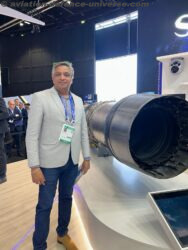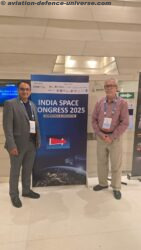
New Delhi. 09 August 2020. “Our end-to-end network modernisation solution for defence forces focuses on building a technology-enabled defence ecosystem and is supported by next-gen networks. This solution is purpose-engineered and caters to the most pressing needs of the forces in terms of synergised tri-forces networks, surveillance & situational awareness, cybersecurity, and more,” stated Sandeep Dhingra, CTO, Network Services and Software, STL in an exclusive interview to Aviation & Defence Universe (ADU).
ADU. STL has made a successful foray into defence sector from Indian Navy’s Project Varun. What is the status quo of this project post the confirmed purchase order?
SD. Project Varun, the Naval Communication Network (NCN) project, is a project of great significance. It is one of the largest ICT modernisation initiatives for the Indian Defence and will be instrumental in compounding naval forces’ strength. After a comprehensive design phase, the project is currently at the completion phase. At a site level, we have delivered 80-85% of the project and expect to complete it in a span of 2 to 3 months.
ADU. Indian Air Force has been having AFNET since 2010. Do you have state-of-the-art solutions to get IAF on the digital readiness curve currently? What makes the next generation of air force network important in the Defence sector?
SD. AFNET is an Air Force owned, operated, and managed digital transformation grid that acts as a backbone for communication for all operational, techno-logistics, and administrative functions. It serves the critical purpose of secure and reliable information exchange, operational efficiencies, and cost-effectiveness. AFNET 1.0 network has been the first network across three wings of Defence forces to offer the highest bandwidth capacity and latest technology for communication. In addition, the IAF has AFCEL, AFNET, Tropo, and IACCS networks to strengthen their digital capabilities. But we need a more Unified, Fortified and Modernised network infrastructure to tap the full power of digital technologies for defence strategy, tactics, and operations. That is where the next generation of AirForce Networks, AFNET 2.0 comes into the picture. This next generation of air force network will bring in all stack modernisation and bolster the strength of IAF on in key areas like:
- Superior cybersecurity
- Service oriented architecture
- Software defined, converged network
- Defence specific Applications like big data analytics, forensic analysis tools
Additionally, AFNET 1, now at the end of the project lifecycle, presents certain vulnerabilities in terms of out of support elements, limited coverage, below par cybersecurity infra, and so on. This makes AFNET 2, an essential and time-critical piece in the overall IAF modernisation strategy.
STL has always been at the forefront of designing and building highly secure and state of the art infrastructure for the defence forces. Be it our Network for Spectrum project for the army, which built ~10000 Kms of intrusion proof network in Jammu and Kashmir or be it the Naval Communication Network (NCN) project which will put our digital naval capabilities at par with the most advanced nations, we are passionate about nation building through the power of digital networks.
ADU. What is the status of the intrusion-proof communication network you had created for the Indian Army in Jammu & Kashmir? Did it expand to all commands and percolated down to the various formation levels? Please give the current status of the project.
SD. NFS was one of a kind project, delivered in one of the toughest terrains in the world. STL successfully delivered this project in 2019 and NFS connectivity and allied benefits have reached the applicable commands (in this case, Northern and Western commands) and all the relevant units or formations.
ADU. How important is it for Indian defence to develop ICT and digitalization initiatives seeing the growing tensions at borders, and do you have solutions tailor-made for it?
SD. In the wake of the multifaceted and ever-evolving defence threatscape and the recent turbulence on the borders, the defence forces should use the formidable power of digital technologies to build strategic deterrence and advanced combat capabilities to achieve the winning edge in both conventional and new age warfare, which cuts across multifarious domains like cyber, electronic and physical.
If we look at the past 5 years, we are reminded of breaches and intrusions over our 15K Km terrestrial borders and critical infrastructures like bases and cantonments. This specifically calls for intrusion proof defence networks and technology-led security solutions.
STL has a suite of services specifically designed and built to bolster our defence forces’ strength through the power of digitisation. Our solutions like end-to-end network modernisation (NetMode), Smart borders, and bases (Sensron+) and cybersecurity are specially designed for defence specific use cases.
Our defence network experts understand the different nuances and specific requirements for Army, Navy, Airforce, and Paramilitary forces and incubate solutions that will help them achieve their strategic goals in terms of mission effectiveness, increased Winnability, competitive advantage and so on.
ADU. Do you have a digital transformation plan for interoperability in the battlefield scenario?
SD. We understand the need for robust tactical communications in the battlefield scenario. STL is developing a well-rounded suite of solutions for these needs. We have developed a Network in a Box Solution which enables adhoc LTE deployments and create a full-blown network in a span of a few minutes. This is very useful on the battlefield because of its low form factor and various deployment options like On ground, in-vehicle, backpack, and weather balloons.
We are also developing MINT (Mobile Integrated Network Terminal) – a compact and mobile communications system capable of enabling reliable communications over hybrid channels like satellite, fixed wireless access, cellular and IP radio. This is a high priority solution for defence with a high degree of interoperability and digital prowess on the battlefield.
ADU. Has STL penetrated into the paramilitary forces and state polices for getting their 3Cs digitised? (capability, credibility, and communication??)
SD. STL is constantly engaging with the paramilitary forces for relevant solutions in the area of CIBMS (Comprehensive Integrated Border Management System), to enable technology-led security on borders that will lead to the fortification of borders and reduction in human causalities. We are also working on solutions for modernising the police networks and bringing in bespoke applications for the same.
ADU. Does STL have a specialised R&D division to create new, futuristic and tailor made solutions for the growing needs of the forces?
SD. STL is constantly investing in research on cutting edge technologies for defence. Our Centre for Smarter Networks innovation lab in Gurgaon is our playfield for incubation and prototyping of new ICT concepts and technologies. Our technology team is thoroughly clued on to the strategic priorities of defence, and we have operationalised different defence use cases like smart borders, surveillance, command, and control centre, at our Centre for Smarter Networks. To state an example, our team recently undertook a detailed survey on the Indo Bangladesh border to incubate a technology-led border management system for the forces.


























































































































